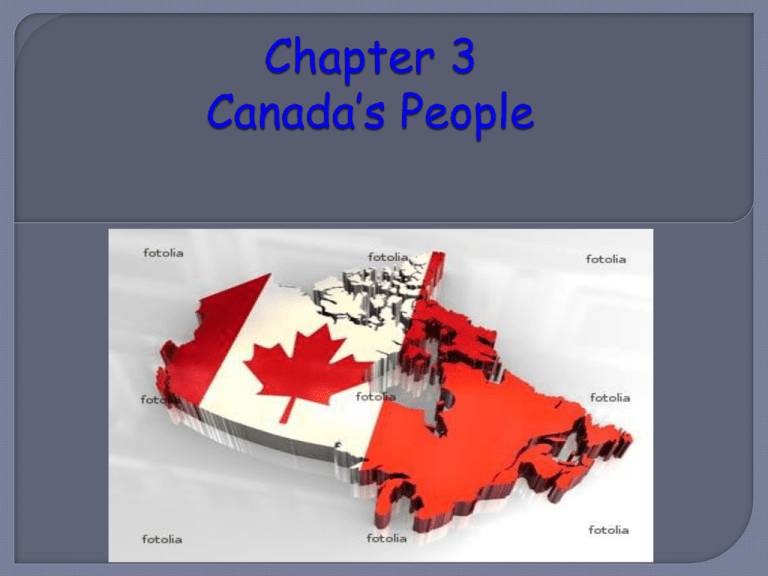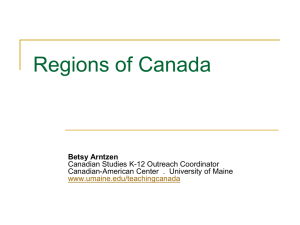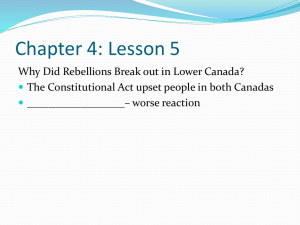Chapter 3 Canada*s People
advertisement

In this chapter, you will investigate geographic influences on patterns of settlement and growth. Canada is a land of regions, many of which are defined to a significant extent by their landforms. You will analyze how regionalism has had, and continues to have, a profound effect on Canadians’ sense of identity. Population Distribution: Describes where people have chosen to live in a particular country. Some geographers refer to Canada's population distribution as an archipelago effect because an archipelago is a group of islands and it compares Canada’s population to small separated groups (islands) spread out not in water but rather in seas of forest, rock, prairie and mountains. Population Density: The average number of people occupying an area. Most Canadians live in Southern Ontario and Quebec. There are large population pockets in the Prarires (Edmonton, Calgary and Winnipeg) as well as the Southwest of B.C. (Vancouver). There are also a couple in Atlantic Canada (mainly Halifax). Population density can be misleading because it does not take into account population distribution. In other words, some places like Toronto may be very crowded but there are many forests and barrens that have no people. Two main categories help determine the location of population. They are: Site Factors – features of the physical landscape, such as good soil, plentiful fish, abundant trees, etc… Situation Factors – Economics, transportation, politics. Long-term contact between First Nations and Europeans almost always lead to the relocation of the First nations because the First Nations had settled the best lands and the Europeans wanted to those lands. 1. 2. 3. Physical landscape (geography) determines settlement patterns. For example: The Great Lakes-St. Lawrence Lowlands were settled for farming because of its fertile land and favorable climate Atlantic Canada developed fishing and shipbuilding because it is on the ocean. In western Canada the rugged coast and mountains promoted fishing and lumbering as major industries. More people live in cities rather than towns because: Cities have more services (i.e. stores, hospitals, schools, museums). Larger cities have more specialized services. There are also many more jobs in cities. The difference between rural and urban areas are urban areas are larger centres. They have populations of more than 1000 or a population density of 400 or more per km2. The Industrial Revolution was the transition from an economy based on agriculture to one based on manufacturing. The development of railways, coal, and steel assisted this change. Rural areas around the country, and province, have began disappearing because of urbanization. Once people started moving to urban centres rural areas began losing more services. Many have become “ghost towns”. Problems with megacities: Poverty Poor water and air quality Traffic Inadequate service (electricity, water & sewage, garbage disposal) Inadequate housing, roads and bridges, etc… Four categories they use to divide regions are: Location Physical and cultural characteristics Political Perspective Hierarchy Canada’s Five Political Regions are: 1. Atlantic Canada 2. Central Canada 3. The Prairies 4. British Columbia 5. The North o o o o The provinces of the Atlantic Region are: Newfoundland and Labrador Nova Scotia Prince Edward Island New Brunswick These provinces form one region because they are all located on the Atlantic Ocean, similar jobs, similar climate, similar traditions and music, etc… The difference in core and periphery is the core is the nucleus of a region, containing its most developed area, greatest wealth, and highest population density. The periphery are all the areas outside the core. Many Canadians identify themselves at different times with their country, their region, their province or their community because of historical and cultural differences of such a large country. Three examples where Canadians identify with their region are: 1. New Brunswick, Quebec and Ontario are known for lumberjacking because of their timber trade. 2. East and west coasters are depicted as fisherman because of their reliance on the sea. 3. The Prairies are known as cowboys because of their reliance on cattle.











